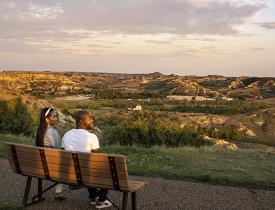Connie Lagerquist: International Peace Garden Horticulturalist
“Once you’re here, there’s just something about this place that just keeps drawing you back and the love for it just gets deeper and deeper.”
Take a good look at the cut rock in the fountain area, and you’ll see the work of her father. Walk through the large spruce trees in the groves and you’ll see the work of her grandfather. And the beautiful floral compositions that are the centerpiece of the International Peace Garden, that’s the work of Connie Lagerquist, the horticulturist.
Connie’s career inspiration came from her mother’s work on her flower beds at home, only six miles from the International Peace Garden on the U.S.-Canadian border near Dunseith. With all her deep-rooted family history in the area, and 30 years of experience on site, “it’s more than just a job, it’s a way of life,” to Lagerquist.

So much goes into the gorgeous floral murals at the International Peace Garden. “I guess I’ve always liked the flowers and now having the opportunity to put not only the designs together, but the different flower textures, the colors, the size of the flowers, it’s an amazing process,” Lagerquist says.
Lagerquist looks for inspiration all over and evaluates types of flowers and how many are needed in each area to make it all work. She starts the seeds and plugs for the more than 155,000 plants in January and can see how they are progressing by March or early April. “When things are growing in the greenhouse and things start to get lush and the colors have come to play like I’ve anticipated them to come to play, I can stand back and say, ‘wow look at the colors in that.’”

Staff members come on once school is out and help prepare the grounds for planting. They work to get the flowers into the ground for the entire month of June. Summer and early fall months are filled with weeding, watering, evaluating how each type of plant performs and visiting with people from all over the world that have come to see the 2,300-acre garden. Once the season is done, the frost hits and the flowers have faded, it’s time to mulch them into the soil and start planning for next year.
All that work goes in the ground for the specific purpose of celebrating the promise of peace between the United States and Canada. For more than 85 years, this place has symbolized and embodied peace and tranquility. “People are wondering if there is still peace on earth,” Connie says, “We know there’s peace on earth, right here at the International Peace Garden.”
Here you can find that peace and tranquility by taking a scenic drive, by allowing yourself to be inspired by the quotes about peace in the Peace Chapel, by literally stopping to smell the flowers in the formal gardens or by being humbled by the towering cacti at the entrance of the conservatory. And if you’ve never visited, Connie urges, “you’ve really got to see this place because it is the best kept secret ever, and we want to share that.”
Connie recommends staying at the campgrounds on site so you can walk through the gardens after everything is quiet and attend a concert at the International Music Camp, also on site.
Connect to the International Peace Garden by taking a drive on the Turtle Mountain Scenic Byway. Also, don’t miss Tommy the Turtle in Bottineau, the World’s largest snowmobiling turtle, and W'eel Turtle in Dunseith, the World’s largest turtle made of tire rims.
Since this interview took place, Connie has retired from her position with the International Peace Garden, but the garden will always hold a special place in her heart.

For more stories, go to ND TravelMatters.












